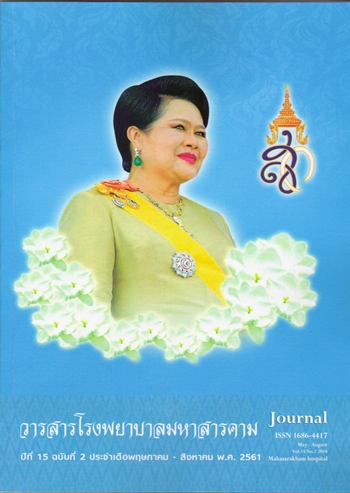บทความฟื้นฟูวิชาการ (Review article) Fever Management Within the First 72 hours in Patients with Severe Traumatic Brain Injury
บทคัดย่อ
ภาวะไข้เป็นปัญหาที่พบได้บ่อยในผู้ป่วยสมองบาดเจ็บรุนแรงในระยะ 72 แรกหลังได้รับบาดเจ็บ ซึ่งเป็นผลมาจากการรบกวนการทำงานของระบบ Hypothalamic mechanisms in thermoregulation หลังสมองได้รับบาดเจ็บ ส่งผลให้อุณหภูมิของสมองและร่างกายสูงขึ้น และเป็นสาเหตุนำไปสู่การบาดเจ็บของสมองในระยะที่สอง ภาวะไข้ในผู้ป่วยสมองบาดเจ็บพบว่ามีความสัมพันธ์กับอัตราการเสียชีวิตและอัตราการเกิดภาวะทุพพลภาพ การจัดการภาวะไข้ในผู้ป่วยสมองบาดเจ็บรุนแรง สามารถแบ่งได้2 วิธีหลัก คือ การบำบัดด้วยการไม่ใช้ยาและการบำบัดด้วยการใช้ยา วิธีการบำบัดด้วยการไม่ใช้ยาพบว่า การลดอุณหภูมิเฉพาะส่วนของศีรษะและลำคอให้อุณหภูมิของสมองอยู่ในภาวะปกติหรือ ต่ำกว่าปกติเล็กน้อย คือระหว่าง 36.0 - 37.5 องศาเซลเซียส ในระยะ 72 ชั่วโมงแรก หลังสมองเกิดการบาดเจ็บหรือการผ่าตัดเปิดกะโหลกศีรษะจะช่วยลดอัตราการบาดเจ็บของสมองในระยะที่สองและมีความสัมพันธ์กับการลดอัตราการเสียชีวิตของผู้ป่วยสมองบาดเจ็บรุนแรง ร้อยละ 7 ในขณะที่การลดอุณหภูมิทั้งร่างกายไม่แนะนำให้ใช้ในผู้ป่วยสมองบาดเจ็บรุนแรง เนื่องจากเป็นการลดอุณหภูมิทั่วร่างกายไม่ได้ลดเฉพาะอุณหภูมิ สมอง ทำให้ไม่มีผลในการรักษาและส่งผลเสียและอันตรายมากกว่ากล่าวคือทำให้เกิดภาวะแทรกซ้อนจากการที่ร ่างกายมีอุณหภูมิต่ำกว ่าปกติส ่วนการบำบัดด้วยการใช้ยา พบว ่าการให้ยาลดไข้ชนิดพาราเซตามอลไม่สามารถลดภาวะอุณหภูมิกายสูงได้ในผู้ป่วยสมองบาดเจ็บรุนแรงและอาจพบภาวะความดันโลหิตต่ำหลังได้ยา นอกจากนี้ปัญหาที่อาจพบหลังการลดไข้คือภาวะหนาวสั่น ซึ่งทำให้เมตาบอลิสมของสมองเพิ่มขึ้นอาจส่งผลให้เกิดภาวะความดันในกะโหลกศีรษะสูง การลดภาวะหนาวสั่นสามารถทำได้โดยการให้ความอบอุ่นแก่ร่างกายผู้ป่วยและการให้ยาลดภาวะหนาวสั่น ซึ่งยาที่มีการแนะนำ คือ พาราเซตามอล
คำสำคัญ : Hyperthermia, Severe traumatic brain injury, therapeutic hypothermia, Head and neckcooling, ภาวะอุณหภูมิสูง, ภาวะสมองบาดเจ็บรุนแรง, การลดอุณหภูมิร่างกาย, การลดอุณหภูมิเฉพาะที่
เอกสารอ้างอิง
สำนักโรคไม่ติดต่อกรมควบคุมโรคกระทรวงสาธารณสุข. รายงานประจำปี2558. สำนักงานกิจการโรงพิมพ์ องค์การสงเคราะห์ ทหารผ่านศึกในพระบรมราชูปถัมภ์, 2559 ;31- 34.
http://social.nesdb.go.th/SocialStat/Stat Report_Final.aspx?reportid=441 &template=2 R1C&yeartype=M&subcatid=15 (สืบค้นวันที่ 3 กุมภาพันธ์2561)
แผนยุทธศาสตร์ระยะ 20 ปีด้านสาธารณสุข ประจำ ปีงบประมาณ 2561. กองยุทธศาสตร์และแผนงาน สำนักงานปลัดกระทรวงสาธารณสุข, 2561 http:// bps.moph.go.th สืบค้นวันที่ 2 กุมภาพันธ์2561
วิทยาลัยประสาทศัลยแพทย์แห ่งประเทศไทย, ราชวิทยาลัยศัลยแพทย์แห ่งประเทศไทย, กรมการ แพทย์กระทรวงสาธารณสุข, สถาบันประสาทวิทยา กรมการแพทย์กระทรวงสาธารณสุข, กรมแพทย์ ทหารบก,กรมแพทย์ทหารอากาศและสำนักงานคณะ กรรมการการอุดมศึกษา.แนวทางเวชปฏิบัติกรณีสมอง บาดเจ็บ(Clinical Practice Guidelines for TramaticBrain Injury).กรุงเทพฯ: บริษัทธนาเพรส จำกัด. 2556
https://www.cdc.gov/traumaticbraininjury/ severe.html สืบค้นวันที่ 16 เมษายน 2561
HickeyJ.V..The ClinicalPracticeof NEUROLOGICAL AND NEUROSURGICAL NURSING.LIPPINCOT WILLIAMS & WILKIN, a Wolters Kluwer business.2014 ; 353.
ธิดา ธรรมรักษา, บุบผาลาภทวี,อมรพลกันเลิศ. ปัจจัย ที่เกี่ยวข้องกับความรุนแรงของการบาดเจ็บในผู้ประสบ อุบัติเหตุจราจร ในหอผู้ป่วยศัลยกรรมอุบัติเหตุและ ฉุกเฉิน โรงพยาบาลธรรมศาสตร์เฉลิมพระเกียรติ. วารสารโรงพยาบาลธรรมศาสตร์เฉลิมพระเกียรติ (TUHJournal online).2558; 1(1) : 13 - 25. http://trsl.thairoads.org /FileUpLoad/ 1616/ 170206001616 .pdf สืบค้นวันที่ 10 เมษายน 2561
Ottens, A.K.,Bustamante, L., Golden, E. C., Yao, C., Hayes, R. L., Wang, K. K. W., et al. Neuro proteomics: A Biochemical Means To Discriminate the Extent and Modality of Brain Injury. Journal of Neurotrauma 2010; 27(10): 1837–1852. http://doi.org/10.1089/neu. 2010.1374
Josephson L. Management of Increased Intracranial Pressure. Dimensions of Critical Care Nursing. 2004; 23(5):194-207
Kuo J.R. & Chio C. C.. Brain temperature management in traumatic brain injury. Formosan Journal of Surgery 2012; 45 (6) : 167-171
Zenker W., Kubik S.. Brain cooling in humans - anatomical considerations. Anatomy and Embryology 1996; 193 (1) : 1-13
Mariak Z., White M.D., Lewko J., Lyson T., PiekarskiP.. Direct coolingof thehuman brain by heat loss from the upper respiratory tract. Journal of Applied Physiology 1999 ; 87(5) :1609-1613
Thompson H.J., Pinto-Martin J., Bullock M.R.. Neurogenic fever after traumatic brain injury: an epidemiological study.J Neurol Neurosurg Psychiatry 2003; 74(5): 614-619.
Mrozek S., Vardon F. and Geeraerts T.. Brain temperature: physiologyand pathophysiology after brain injury. Hindawi Publishing Corporation Anesthesiology Research and Practice Volume 2012, Article ID 989487, 13 pages doi:10.1155/2012/989487
Connolly Jr. E.S. , Rabinstein A. A. & Carhuapoma Juan. (2013). Guidelines for the management of aneurysmal subarachnoid hemorrhage a guideline for healthcare
professionals from the American Heart Association/American Stroke Association. 10. 217-224.10.3969/j.issn.1672-5921.2013.04.013.
Amorima R., Bor-Seng-Shu E. S., Gattas G., Paiva W., Andrade A., Teixeira M.. Decompres sive craniectomy and cerebral blood flow regulation in head injured patients: A case studied by perfusion CT. Journal of neuroradiology. Journal de neuroradiologie. 2012; 39. 10.1016/j.neurad.2012.02.006.
Dietrich W.D., Alonso O., Halley M., Busto R.. Sevoflurane and halothane reduce focal ischemic brain damage in the rat: Possible influenceonthermoregulation. Anesthesiology 1993;79.985-92.10.1097/00000542-199311000- 00017.
Karnatovskaia, L. V., Wartenberg, K. E., & Freeman, W. D.. Therapeutic Hypothermia for Neuroprotection: History, Mechanisms, Risks, and Clinical Applications.The Neurohospitalist 2014; 4(3):153 - 163http://doi.org/10.1177/ 1941874413519802
Clifton G.L., Miller E.R., Choi S.C., Levin H.S., McCauleyS.,SmithKR. Jr.etal. .Lackofeffect of inductionof hypothermia after acute brain injury. The New England journal of medicine 2001; 344(8):556-63.
Marion D.W., Darby J., Yonas H.. Acute regional cerebral blood flow changes caused byseverehead injuries. journalofneurosurgery 1991; 74(3):407-14.
ViguéB.,Ract C., Zlotine N.,LeblancP.E.,Samii K., Bissonnette B.. Relationship between intracranial pressure, mild hypothermia and temperature-corrected PaCO2in patients with traumatic braininjury. intensivecare medicine 2000; 26(6):722-8.
ดวงเพ็ญ แวววันจิตร.การพัฒนาและการประเมินการ ใช้แนวปฏิบัติการพยาบาลในการจัดการกับภาวะไข้ใน ผู้ป่วยบาดเจ็บสมอง โรงพยาบาลสงขลานครินทร์, วิทยานิพนธ์หลักสูตรพยาบาลศาสตรมหาบัณฑิต (สาขาการพยาบาลผู้ใหญ่มหาวิทยาลัยสงขลานครินทร์ 2554.
Childs C. & Lunn K.W.. Clinical review: Brain-body temperature differences inadults withseveretraumatic braininjury.Critical Care. Apr 2013; 17(2):222. doi: 10.1186/cc11892
Gilbert, M., Barton, A, J. & Counsell, C. M.. Comparison of oral and tympanic temperaturesinadultsurgical patients. Applied nursingresearch: ANR.2002;15:42-7.10.1053/ apnr.2002.29528
ดาวน์โหลด
เผยแพร่แล้ว
รูปแบบการอ้างอิง
ฉบับ
ประเภทบทความ
สัญญาอนุญาต
วารสารนี้เป็นลิขสิทธิ์ของโรงพยาบาลมหาสารคาม






